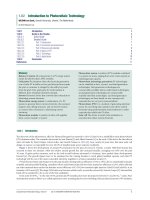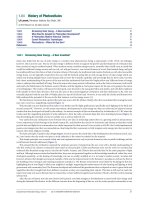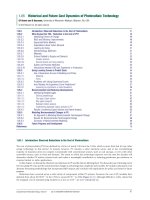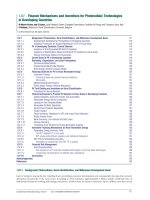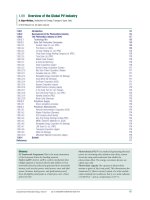Volume 1 photovoltaic solar energy 1 04 – history of photovoltaics
Bạn đang xem bản rút gọn của tài liệu. Xem và tải ngay bản đầy đủ của tài liệu tại đây (2.18 MB, 15 trang )
1.04
History of Photovoltaics
LA Lamont, Petroleum Institute, Abu Dhabi, UAE
© 2012 Elsevier Ltd. All rights reserved.
1.04.1
1.04.2
1.04.3
1.04.4
1.04.5
References
Harnessing Solar Energy – A New Invention?
What Was the Catalyst for Photovoltaic Development?
A Photovoltaic Modern Historical Timeline
Current Photovoltaic Technologies
Photovoltaics – Where We Are Now?
31
33
37
41
43
44
1.04.1 Harnessing Solar Energy – A New Invention?
Many may think that the use of solar energy is a modern time phenomenon being a repercussion of the 1970s’ oil embargo;
however, this is not the case. The use of solar energy in different forms to support the growth and development of civilization has
been around as long as mankind existed. When modern society considers energy sources, normally what would come to mind first
would be traditional energy sources such as coal, oil, and gas; however, our current biomass of wood, dried animal dung, and peat
has traditionally been the choice of fuel of ancient cultures. Obviously, the traditional and modern biofuels, as with other renewable
energy forms, are all originally created from the sun with the biofuels acting like an early storage device of solar energy which was
useful only during daylight hours. Early humans did not have the scientific capability and knowledge that we have today, but they
had a basic understanding of the power of the sun and they understood that from this ‘bright yellow star’ different forms of energy
came to enhance their standard of living. This is the reason why many ancient civilizations, such as the Native Americans, both north
and south, the Babylonians, the Persians, ancient Hindus, and the Egyptians, had a great respect for the sun, even going to the extent
of worshipping it. The Greeks, well known for their gods, were devoted to the sun gods Helios and Apollo, and with their traditions
built temples to show their devotion. This was also seen in the ancient Egyptian Civilization and their dedication to Ra, who was
normally depicted with the sun disk of Wadjet placed on top of his falcon head. However, it was really the Greeks and Romans who
fully embraced the potential of the sun in the first instance as a free energy source [1].
The first known invention that captured the solar rays was in 600 BC (before Christ) when fire was initiated by focusing the solar
rays onto wood via a magnifying material (Figure 1).
This principle was not abandoned but rather it was further used for light applications, specifically torch lighting in the third and
second century BC. However, as with many innovations, developments in solar energy are often not only used to improve human
comfort but also developed and used by the military. An ancient example of this was introduced by Archimedes in 212 BC when the
Greeks used the magnifying principle of solar radiation to burn the sails on Roman ships that were attacking Syracuse (Figure 2),
thus diversifying the potential of solar to include war as well as daily life [3].
Very rarely does any civilization move forward with a new idea or technology unless there is a growing need for advancement:
Greece experienced a fuel shortage in the fourth century BC, and therefore the need to be innovative and initiate an idea that would
provide heat and light for its communities was vitally important for their survival. From as early as 400 BC, the Greeks implemented
passive solar designs into their accommodations, thus being the first community to fully integrate solar energy into their society for
reasons other than religious worship.
The basic principle of passive solar design (Figure 3) was to protect the north side of the building from the elements (wind, rain,
etc.) and ensure that the south was open to solar radiation in the winter but shaded in the summer.
This simple principle was accepted widely and was implemented not only in private homes but also in public buildings and the
world famous Roman bathhouses (Figure 4).
This ensured that the civilization captured the optimum amount of energy from the sun; even with a limited understanding of
why this worked, the cultures constructed cities based on this principle. Greeks and Romans were not the only two societies that
embraced this abundant energy source, but also the Pueblo, Anasazi, and Chinese also used the idea for the same purposes of light
and heat. Although many societies had similar ideas, they were not generated together or the knowledge transferred, rather they were
developed separately, as the sharing of knowledge was not as readily available as it is in today’s modern society. Societies did
however advance their designs and a good example of this was the improvement by the Romans to use glass to enclose the heat in
the building, hence storing it and ensuring maximum warmth [1]. The Roman Government went further by declaring the first law
highlighting that it was illegal to block your neighbor’s sunlight, supporting the embracement of solar heating and lighting at both
government and community level. The Romans developed and embraced the greenhouse idea we depend on now to grow fruits and
vegetables that they brought back from different countries as they were expanding their empire. This idea is still used in much the
same form today as it was in Roman times to ensure that we have sufficient supplies and varieties of food to feed the world, ensuring
self-survival.
After the turn of history into the anno Domini (AD) period, very little changes or developments occurred with solar energy until
during the Industrial Revolution. In the different centuries from the beginning of this era, acts by certain people/communities to use
Comprehensive Renewable Energy, Volume 1
doi:10.1016/B978-0-08-087872-0.00102-5
31
32
Photovoltaic Solar Energy
Figure 1 Creating fire from the sun [2].
Figure 2 Archimedes mirror burning Roman military ships [4].
Figure 3 Passive solar design in Anasazi cliff [5].
the heat and light of the sun were noted but no improvements or breakthroughs were highlighted or noted. In 100 AD, Pliny the
Younger (Figure 5), who was a lawyer, author, and Roman magistrate, was documented as having a summer house in Italy with
what we would consider today a conservatory, but as mentioned before this use of the sun was common in Greek and Roman times
so was not a new idea [7].
Furthermore, it was recorded that the North American Pueblo people in 1200 AD discovered and embraced the benefits of
passive solar. By the eighteenth century, it was accepted as normal for the upper classes to have greenhouses, and this was further
expanded in the nineteenth century when people with wealth constructed conservatories (Figure 6) for people to relax, walk, and
enjoy warmth in very pleasant surroundings.
However, the next step proved to be the most complicated period with the move from the sun as the provider of light and heat to
a supplier of much more. The mystery of energy from the sun truly eluded societies until the nineteenth century when one discovery
opened many possibilities for the sun to be a future energy-supplying giant.
History of Photovoltaics
33
Figure 4 Roman bathhouses [6].
Figure 5 Pliny the Younger [8].
Figure 6 Conservatories first initiated by Romans [9].
1.04.2 What Was the Catalyst for Photovoltaic Development?
As discussed previously, for centuries we have been using the power of the sun in a number of basic ways. However, it was not until
the 1800s that the scientific breakthrough happened to enable us to fully harness all the potential of this free, largely abundant
fuel source. The credit of this turnaround in the use of solar energy is due to a publication in 1839 by a physicist Edmund Becquerel
(Figure 7) from France, who discussed an experiment he had undertaken with a wet cell battery [10].
34
Photovoltaic Solar Energy
Figure 7 Edmund Becquerel [11].
Light
Thin
membrane
Pt electrodes
Acidic
Solution
Blackened box
Figure 8 Photoelectric effect [14].
During his investigation, Becquerel discovered that when sunlight is made available to the silver plates, the output voltage of the
battery increased (Figure 8). This discovery paved the way for other researches [12, 13]; however, it was not a priority at the time as
fossil fuel was reasonably priced and in abundant supply.
Some other support of this original discovery was undertaken during the 1800s, but progression to prove was slow until the
mid-twentieth century. Adams (Figure 9) and Day discussed in a publication the effect of sunlight on selenium, and later in 1883,
an electrician Charles Edgar Fritts from New York designed a very inefficient (1–2%) prototype cell that is similar to the typical cells
used today [15].
The efficiency of this and all other cells is calculated by measuring the electricity produced from the total of possible energy that
hits the photovoltaic (PV) surface. The prototype held many of the characteristics of today’s solar cells – it had a glass cover beneath
which was a mass of fine gold wires sandwiched between glass and a thin layer of selenium. This was the first model for scientists to
improve further, but it would take many decades before an increased efficiency was achieved and a true understanding of the
reasons of the earlier low output was reached.
Little development had occurred over the half century since the initial discovery and whether this was due to lack of knowledge,
lack of interest, or the constant low price of fossil fuels is not clear. The first half of the twentieth century was to follow much the
same trend with the only real notable occurrences being Planck’s (Figure 10) new idea regarding his light quantum hypothesis [17]
which supported Albert Einstein’s (Figure 11) 1905 paper [18] on the photoelectric effect that won him the Nobel Prize in 1921.
History of Photovoltaics
Figure 9 William Grylls Adams [16].
Figure 10 Max Planck [19].
Figure 11 Albert Einstein [20].
35
36
Photovoltaic Solar Energy
Figure 12 Bell Labs scientists Daryl Chaplin, Calvin Fuller, and Gerald Pearson. Courtesy of John Perlin Bell Labs silicon solar cell [24].
The second half of the twentieth century was to see faster progression, some of which was just natural scientific progression but
also some historical occurrences helped to speed up the growth of PV cells. Bell Labs researchers in America were responsible for one
of the largest discoveries that turned the solar industry into what we see today and unbeknownst to them it was their work in
semiconductors that would actually support the development of solar cells [21, 22]. Semiconductors are the middle ground
between conductors and insulators and are made from silicon that is doped and the researchers at Bell Labs had seen silicon
reaching better results than the previously tested selenium [23]. They, for the first time, foresaw the possibility for solar cells with
efficiencies of more than 20% compared with current levels of 1–2%. The team (Figure 12), however, realized that they could not
make this significant step with only the transition to a different material and they continued to undertake research to find an
optimal p–n junction.
Bell researchers discovered that they could achieve 6% (US$250 per watt versus approximately $3 per watt for coal) cell
efficiency by mixing arsenic with silicon and placing a thin coat of boron on the cell [25]. Probably unknown to the scientists
they had started a revolution in energy supply that in less than 20 years would be needed worldwide even if their discovery was a
spin off from their transistor technology and expertise. Even with the advancement, the current product was too expensive for
terrestrial use; however, for space power applications, it was the perfect solution as there was no other alternative, so despite its
negative points it was still the best solution [16].
The first of many solar cells for powering space machines was placed on the Vanguard I space satellite in 1958 and this worked
until it was decommissioned in 1964 [26]. The huge success of PV cells as an endless and nonpolluting power supply has ensured a
place for these cells in the space industry (Figure 13) independent of cost and efficiency [27].
As more improvements and developments have been made to cells so has the option of where they can be incorporated. As the
efficiency continues to improve, the efficiency of PV cells improved to 14% by Hoffman Electronics (1960) [29], so does the
Figure 13 Solar-powered space satellite [28].
History of Photovoltaics
37
transition between using these cells only in space and a future of installing them in terrestrial applications. However, in the early
1970s, there were still limitations with only the powering of systems in remote locations with no grid excess being considered a
possibility.
From a sustainability point of view, it is a shame that such a major source of energy as solar technology took so long to develop
and expand due to the continuing popularity of fossil fuels. This would probably still have been the situation if the oil crises in
1973 and 1979 with the OPEC oil embargo had not occurred [16, 30]. This substantial rise in oil prices and huge shortages of oil
specifically in America forced the government to realize that this dependency on foreign fossil fuel was a risky business and
highlighted the volatility of the traditional energy market, especially when there was free access to the sun, the most powerful fuel
source. At this point, more interest was initiated in ‘alternative’ energy through research and development (R&D) as well as
government incentives that helped to support the acceptance of renewable energy [31, 32].
During the 15-year period from 1970 onward, PV cells saw a huge growth, which culminated in a breakthrough in the price of PV
cells per watt to under one-tenth of its previous cost in this short period (1970 – $100 per watt to 1985 – $7 per watt). This could
have continued if the oil price had not dropped again, which meant people quickly forgot about the issues of the decade before and
went directly back to their old habits, meaning that for another extended period progress was limited and the world went back to
embracing fossil fuels. Even the government’s support during this period was somewhat focused in the wrong direction as it did not
see the importance of supporting the PV companies to develop the systems that would have speeded the progression of solar
technology; rather it directed its efforts to universities for large-scale R&D making the public’s access to this technology more
difficult. Another factor that played an important part in the slow development of this technology was the attitude of the fossil fuel
providers which traditionally most communities and governments depend on for energy. This industry did not support the
development of alternative energy initially providing it with a challenging path; however, this has changed as nowadays most
people widely accept the idea of renewable energy as a supporting source to the traditional source.
The United States very much took the lead in solar cell development after the initial nineteenth century French discovery, and until
1990 they were the leaders in the market, R&D, and implementation. Nevertheless, this changed at the end of the twentieth century
with this domination moving and splitting between Europe and Japan. In this decade, the world reached a huge milestone with one
million homes integrating some type of solar power. During this period, both Japan and Europe, particularly Germany, introduced
government subsidies, increased public awareness, and invested in R&D. In the 1990s, Japan had seen its market increasing 10-fold
with Germany floundering initially but modifications to its subsidies had seen its output rise by a multiple of 40 even topping Japan’s
success. Other European countries such as Spain have followed their lead and achieved much the same growth.
The PV market has completed an exciting part in its history with R&D still ongoing together with product development for tasks
such as lighting, desalination, and pumping, and hence making it interesting not only to scientists and engineers but also to the
general public (Figures 14 and 15).
Solar energy is now not only a more accessible power supply to satisfy the ever-growing demands but it also has lower costs, has
higher efficiency, and is a clean alternative to fossil fuels.
1.04.3 A Photovoltaic Modern Historical Timeline
The previous section discussed the major events that happened to develop solar energy to what it is today; however, many other
smaller events played their part in the growth of this technology. Table 1 outlines the year of the event, the person/company/
country responsible, if available, together with a summary of the discovery outlining the modern history of PV technology.
Figure 14 PV on homes [33].
38
Photovoltaic Solar Energy
Figure 15 Large-scale PV plants [34].
Table 1
Glimpse of the modern PV history
Year
Person/company/country
Summary of discovery
1839
Alexandre Edmond Becquerel
1873
Willoughby Smith
1876
Richard Day, William Adams
1877
1883
1887
William Adams
Charles Fritts
Heinrich Hertz
1888
1901
1904
Edward Weston
Nikola Tesla
Wilhelm Hallwachs
1905
Albert Einstein
1914
1916
1918
Goldman and Brodsky
Robert Milliken
Jan Czochralski
1921
1932
Albert Einstein
Many scientists
The photoelectric effect (light to electricity conversion) which saw both the conductance and
illuminance rise during an experiment he was undertaking with metal electrodes and electrolyte
Selenium sensitivity to light was discovered during another experiment he was undertaking
promoting branching into selenium solar cell experiments
Smith’s discovery of the photoelectric effect on selenium was further verified and advanced by
testing it with a platinum intersection which experiences the same phenomenon
Constructed an initial solar cell from selenium
Explained the selenium wafer solar cell with his version having approximately 1–2% efficiency
The effect of ultraviolet light on reducing the minimum value of voltage capable of inducing
sparking between a pair of metal electrodes was tested
‘Solar Cell’ obtained first US patent [35]
US Patent ‘Method of Utilizing and Apparatus for the Utilization of Radiant Energy’ [36, 37]
Further discoveries continued with regard to photosensitive material mixing specifically cuprous
oxide and copper
Published on the photoelectric effect – ‘On a Heuristic Viewpoint Concerning the Production and
Transformation of Light’ [18]
PV barrier layer was discovered
Proved Albert Einstein’s 1904 photoelectric effect theory
Discovered a method to nurture single-crystal silicon, hence supporting the development and
future production of solar cells using monocrystalline silicon based material
Nobel Prize for 1904 paper on photoelectric effect
More material combinations were being observed to react to the photoelectric effect, specifically
cadmium selenide
Development of the initial monocrystalline solar cell made from silicon was completed
Primary solar cells using germanium were built as advancements enabling a p–n junction of a
single-crystal cell of this material to be grown
Completed research on theoretical solar cell material efficiency and the wavelength of the solar
spectrum [38]
Published on the photoelectric effect of cadmium sulfide [39]
1941
1951
1953
Dan Trivich
1954
Reynolds, Leiess, Antes, and
Marburger
AT & T
Pearson, Chapin, and Fuller – Bell
Laboratory
1954
1954
1954
1955
1955
1955
1955
1957
1957
1958
1958
Mort Prince and team
Western Electric
Hoffman Electronics – semiconductor
division
Hoffman Electronics
Chapin, Fuller, and Pearson AT & T
Hoffman Electronics
Solar cell operations were widely exposed to the American public
Solar cells produced using silicon with 4.5% efficiency. This work was developed from a discovery
that researchers made on the photoelectric effect on silicon when conducting another project on
semiconductors [23]
Bell Labs broke its own efficiency record by 1.5%, raising the new level to 6% in a short time frame
Initial research into powering satellites using solar cells commenced
Silicon solar cell production commercial license
Produced a PV with the following specification per cell: 14 mW peak power with 2% efficiency for
US$25
In Chicago, a car powered by solar energy was unveiled
Efficiency of PV improved to 8%
Patent issued – ‘solar energy converting apparatus’ [40]
Efficiency of PV improved to 9%
Solar cell was designed to withstand the radiation in space
(Continued)
History of Photovoltaics
Table 1
39
(Continued)
Year
Person/company/country
Summary of discovery
1958
1958
1958
1959
1959
1960
1961
1961
1962
1962
1963
1963
1964
1965
US Signal Corps
USA
Russia
Hoffman Electronics
USA
Hoffman Electronics
United Nations
Defence Studies Institute
Bell Labs
First space satellite which was PV powered named Vanguard I was designed and operated for 8 years
Explorer III and Vanguard II – other solar-powered satellites launched
Sputnik III solar-powered satellite launched
Efficiency of their PV improved to 10%
Explorer VI and VII launched with the previous having 9600 cells
Efficiency of their PV improved further to 14%
Conference was held on solar energy applications in the developing world
First PV specialist conference
Telstar telecommunications commercial satellite with 14 W peak power
Second PV conference
First viable silicon PV module
World’s largest 242 W PV array for powering a lighthouse was installed
New largest 470 W PV array for powering a space project (Nimbus) was designed
Designed the edge-defined film-fed growth (EFG) process. Tyco Labs were the first to create crystal
sapphire ribbons after the silicon version
1 kW PV power astronomical observatory was launched and went into earthly orbit
The idea of a solar power satellite system was announced [41]
Another satellite (OVI-13) was launched, but this time with two cadmium selenide panels as power
supplies
Founding of Spire Corporation, which was a company that aimed to continue to be important in
solar cell manufacturing
All the historical developments to date and the high interest in research has ensured the constant
reduction of PV technology to approximately 80% of the original cost, hence making it more
readily available for common low-power applications
Used a cadmium selenide PV to power a TV, which was used for educational purposes in Africa
(Niger)
Company founded
Beginning of commercial operation and opening of sales division
Two NASA experts with experience in PV satellites founded this company
Development of initial domestic PV cells and thermal combined appliances
A $30 per watt cell was developed
An initiative by the Japanese to further enhance, develop, and research in this area
One-inch EFG ribbon using the endless belt process
Established Solar Technology International
Research and development for earth-based PV systems at this lab was supported by the US
Government. This occurred from an industrial conference recommendation
Established Solar Power Corporation
Produces silicon ribbon crystal modules
From 1976 to 1985 and also from 1992 to 1995, the NASA Lewis Research Centre (LeRC) worked
on integrating PV cells into small power systems that could be used in many areas especially rural
places with limited power
Amorphous silicon cell was introduced
Established
Established the National Renewable Energy Lab (NREL) in Colorado initially known as the Solar
Energy Research Institute (SERI)
This year the sum of all the PV modules produced topped 500 kW
Six strategically placed meteorological stations in the United States were introduced for recording
data
Placed in a Papago Indian community the first PV system which supplied the power requirements
for the entire village. The system was 3.5 kW and supplied power and pump water for 15 homes
Established
This company based in California built the largest PV production facility to date
Installed a pumping station of 1.8 kW which was then upgraded to 3.6 kW in Burkina Faso
60 kW diesel–PV hybrid system for powering a radar station was installed in Mount Laguna in
sun-drenched California
1 MW per year peak power PV module produced
New company BP Solar
For just more than 10 years they produced 95% of the world’s solar-based electricity. However,
when the price of fossil fuels reduced, they closed due to lack of investor support
105.6 kW system built by a Utah company. The system integrated modules produced by
Spectrolab, ARCO Solar, and Motorola. An interesting fact is that this system is still operational
Sharp Corporation
Japan
USA
Tyco Labs
1966
1968
1968
NASA
Peter Glaser
1969
Roger Little
1970
1972
France
1972
1973
1973
1973
1973
1974
1974
1975
1975
Solar Power Corporation
Solar Power Corporation
Solarex Corporation
Delaware University
Project Sunshine
Tyco Labs
Bill Yerkes
Jet Propulsion Laboratory
1975
1976
1976
Exxon
Kyocera Corp
NASA
1976
1976
1977
RCA Lab
Solec International
US Department of Energy
1977
1977
NASA (LeRC)
1977
NASA (LeRC)
1979
1979
1979
1979
Solenergy
ARCO Solar
NASA (LeRC)
1980
1980
1980
ARCO
BP
Luz Co.
1980
Wasatch Electric
(Continued)
40
Table 1
Photovoltaic Solar Energy
(Continued)
Year
Person/company/country
Summary of discovery
1981
NASA LeRC
1981
1981
Solar Challenger
USA
1981
1981
1982
1982
1982
Saudi Arabia
Helios Technology
1982
1982
1983
1983
Volkswagen
Solarex Production
1983
ARCO Solar
1983
1983
Solar Power Corporation
NASA LeRC and Solarex
1983
1984
Solaria Corporation
David Carlson and
Christopher Wronski
For 3 years they worked on powering remotely located refrigerators for vaccine which was tested in
30 worldwide locations
Maiden voyage of the first solar-powered plane
Solar projects
90.4 kW – Square Shopping Centre, Lovington, New Mexico, powered by Solar Power Corporation
modules
97.6 kW – Beverly High School, Beverly, Massachusetts, powered by Solar Power Corporation
modules
10.8 kW peak power desalination system in Jeddah, Saudi Arabia, powered by Mobil Solar
First European PV manufacturer was established
Above 9.3 MW PV power produced worldwide
1 MW dual tracking PV plant called Solar’s Hisperia in California was grid connected
Unveiled two PV-powered systems for testing a power supply for public lighting and for terrestrial
satellite reception stations
A system used to start a car by placing 160 W peak power PV on the car roof top was tested
Solar rooftop project of peak power 200 kW
21.3 MW peak power produced worldwide
1 kW powered vehicle which participated in the Australia Race driving for 20 days and 4000 km with
an average speed of 24 km h−1 and a maximum speed of 72 km h−1. However, later in the same
year, the car outperformed itself by traveling further than 4000 km in 18 days on its journey
between Long Beach and Daytona Beach
6 MW power plant grid subsystem for Pacific Gas and Electric Company which was enough to
supply 2000/2500 homes
A Tunisian village was supplied with four systems with a combined power of 124 kW
Built a system of 1.8 kW in Guyana to maintain power for basic hospital power requirements such
as lighting, radios, and medical refrigerators. Other places were also provided with similar
systems such as 4 kW in Ecuador and 1.8 kW in Zimbabwe
Merged with Amoco Solar, which was owned by Standard Oil
They were presented the IEEE Morris N Liebmann Award for their work in “use of amorphous
silicon in low cost, high performance photovoltaic solar cells”
Sacramento in California has a 1 MW PV power plant
Amorphous modules first shown
Remote medical and school basic power supplies in Gabon by 17 separate systems
Grid-connected 30 kW system in Southampton, UK
BP Solar expanded by purchasing Monosolar thin-film division
20% solar cell efficiency obtained
The Tour de Sol which ran from 1985 to 1993 based in Switzerland was another race for
solar-powered vehicles. As the years progressed, different classes opened providing not only
direct solar-powered cars the right to participate but also other solar-powered vehicles
Unveiled the first thin-film PV
Provided a PV system of 50 kW in Pakistan for projects the United Nations was undertaking
7 MW per year thin-film production possible. In addition to production in California, the company
expanded its production to Germany and Japan
Thin-film technology patent
Company created out of the amalgamation of Energy Conversion Devices Inc. (ECD) and Canon Inc.
Bought by Siemens and renamed Siemens Solar Industries
First country to launch a program that aimed to get community embracement of solar energy –
$500 million ‘100 000 solar roofs’ program. This program focused not only on homes but any
building including churches with the Cathedral in East Germany embracing this initiative
Name changed to BP Solar International as well as being a new division in the BP company
New location for remote power application
Patent of a 20% efficiency silicon cell
Japan is the next country to follow Germany’s subsidy lead with its ‘70 000 Solar Roofs’ program
Launched its website providing more access to information on renewable energy
German company ASE GmbH took over Mobil Solar Energy Corporation creating ASE Americas Inc.
The two groups along with Siemens Solar collaborated to support renewable energy projects which
enhanced system commercialization in India
Expanded their business by taking over APS’s California production premises. In the same year,
they further expanded their product line to include the production of CIS
The Icar plane, which was powered by solar cells, had a total surface area of 21 m2 covered by 3000
cells
ARCO
NASA LeRC
Solar Trek
1984
1984
1984
1984
1984
1985
1985
ARCO
NASA LeRC
BP Solar Systems and EGS
BP Solar
University of New South Wales
Urs Muntwyler
1986
1989
1989
ARCO Solar
Solarex
ARCO Solar
1989
1990
1990
1990
BP Solar
United Solar Systems Corporation
ARCO Solar
Germany
1991
1992
1992
1994
1994
1994
1995
BP Solar Systems
Antarctica
1996
Japan
National Renewable Energy Lab
ASE Americas Inc.
World Bank and Indian Renewable
Energy Source Agency
BP Solar
1996
Icar
(Continued)
History of Photovoltaics
Table 1
41
(Continued)
Year
Person/company/country
Summary of discovery
1997
General Motors Sunracer vehicle
1998
California
1999
2000
First Solar LLC
Japan
2001
2002
2003
NASA and Aero Vironment Inc.
California Public Utilities Commission
Germany
2004
Germany
2004
2004
2005
2006
GE
Worldwide
California Solar Initiative
This vehicle won the race through Australia called the Pentax World Solar Challenge with 71 km h−1
average speed
$112 million program called ‘Emerging Renewable Program’ to support residential and commercial
PV systems
Created through the combination of True North Partners, Solar Cells Inc., and Phoenix LLC
During these 2 years the output of Japanese products grew with Kyocera and Sharp, each
producing enough peak power for a country like Germany
HELIOS, another solar-powered plane, achieved a record height of 30 000 m
An incentive program of $100 million for PV systems less than 30 kW was initiated
Continued to expand their acceptance of PV systems by building many more projects such as the
example at Hemau, which was connected to the grid and considered the largest of its time (4 MW)
Solarparks of up to 5 MWp were built in Leipzig, Geiseltalsee, Gottelborn, and other locations due to
energy laws from the German Government
60% of PV market is held by BP Solar, Kyocera, Sharp, Shell Solar, and RWE SCHOTT Solar
Purchased Astropower, the final American independent PV producer
55 countries have embraced solar energy
A three billion dollar 10-year funded solar initiative was announced which commenced the
following year with great interest and acceptance
7 GW of PV modules installed
$2.8 billion toward incentives
40% efficiency achieved on a PV cell
9.5 GW of PV modules installed
Solar panel project initiated
42.8% efficiency achieved
15 MW installation
Reached 40.8% efficiency
16 GW of PV modules installed
6.9 GW of PV cells are produced worldwide
20 MWp, which was at the time the world’s largest plant
Initiated a requirement for utilities to have at least 33% of renewable energy portfolio
23 GW of PV installed, with annual production of 11 GW
Typical commercial efficiency is now 15%
Moved production from the United States to China
Installed more solar panels for hot water at his home
From 2006, worldwide there has been an addition of approximately 16 000 MW of solar power
40 GW of PV capacity
Accounts for approximately 80% of the worldwide PV market
In 2 years, PV capacity is 2 GW
70% of its PV systems are off-grid
Current top five solar PV countries in order are Germany (17.3 GW), Spain (3.8 GW), Japan
(3.5 GW), Italy (3.5 GW), and the United States (2.5 GW)
Annual production of PV modules is currently at 24 GW, which is a doubling from the previous year
The top three countries that added the most solar are Germany, Italy, and Czech Republic
PV systems are implemented in more than 100 countries
25% of PV systems are utility-scale PV plants
From the top 15 PV-manufacturing companies 10 are located in Asia
Purchased more than half the PV modules produced
Increased the amount of electricity produced by PV systems by 87% over the previous year
119 countries have embraced solar energy
New countries that have utility-scale PV systems include Bulgaria, China, Egypt, India, Mali,
Thailand, and United Arab Emirates
World’s largest PV manufacturer
Produces two-thirds of the PV modules manufactured
2006
2006
2006
2007
2007
2007
2007
2008
2008
2008
2008
2008
2009
2009
2010
2010
2010
2010
2010
2010
2010
2010
Worldwide
California Public Utilities Commission
Worldwide
University of Delaware
Nellis Solar Power Plant
NREL
Worldwide
Worldwide
Siemens
California Governor
Worldwide
BP
US President
Worldwide
Worldwide
Europe
Czech Republic
Australia
Worldwide
2010
2010
2010
2010
2010
2010
2011
2011
2011
Worldwide
Worldwide
Worldwide
Worldwide
Asia
Germany
Germany
Worldwide
Worldwide
2011
2011
Suntech Power Holdings – China
China
1.04.4 Current Photovoltaic Technologies
In the previous sections, we have discussed the history behind the development of PV technology, where it started, and why it
developed quicker during certain periods of history. We did not investigate how the technology has branched out with relation to
the combination of material used or the production methods selected. It is not only important where the technologies are now but
rather how they got to this point and what are the historical steps to arrive at today’s technology.
42
Photovoltaic Solar Energy
The efficiency and cost of the panels have been the two major issues in the development of PV technology, and still are today.
There is an interlinking generally between the increase in efficiency and the cost, as normally they both rise and fall together. For
example, the increase in cost due to more expensive materials could lead to identical $/W when the efficiency is increased at the
same rate; or scale effects in manufacturing generally lead to cost reductions provided the efficiency remains at least the same.
However, depending on the commercial use and market development, cost will be a major issue rather than efficiency as every
manufacturer is trying to develop the ‘super cell’, which has high efficiency and low cost. In reality, a variety of cells and modules in
terms of cost and efficiency are needed to provide an optimal solution for varying power system requirements.
Currently, there are two main areas in R&D: one is in the material being used and the other is in the construction of the cells. Let
us first consider the latter by showing the effect of the number of junctions in a cell on cell efficiency. Figure 16 shows the
development of efficiency over three decades; it illustrates how much it has improved from the single-crystal single-junction gallium
arsenide cell in 1980 of 22% to today’s three-junction concentrators with 42.5% efficiency [42].
Within specific materials, there are advancements trying to further develop them, but sometimes the first prototype model
provides the best results as with crystalline silicon cells the first developed single crystal has the highest efficiency of this family even
if other attempts of improvements are ongoing (Figure 17).
One of the new second-generation technologies that is proving interesting is thin-film technology, and the many material-based
variations. The development of this technology started in 1976 with cadmium telluride (CdTe) and amorphous silicon (a-Si), with
the development of copper indium diselenide or copper indium gallium diselenide (Cu(In,Ga)Se2) starting a year later in 1976.
Although CdTe started with the highest efficiency, it was not long before Cu(In,Ga)Se2 caught up and even overtook it with fast
development in output efficiency. However, a-Si was initially lower than the first thin-film technologies and never managed to catch
up or overtake the leaders. Over two decades later for about 4 years researchers started to look at nano-, micro-, and poly-Si thin
45
40
35
30
25
20
15
10
5
0
1980
1985
1990
1995
2000
2010
2005
Single-junction single-crystal GaAs
Thin-film single-crystal GaAs
Two-junction concentrators
Three-junction concentrators
Figure 16 Effect of the number of junctions on efficiency [42].
30
25
20
15
10
5
0
1980
1985
Single crystal
1990
Multicrystalline
Figure 17 Efficiency development of the silicon family [42].
1995
2000
Thick silicon film
2005
2010
Silicon heterostructures
History of Photovoltaics
43
25
20
15
10
5
0
1980
1985
1990
1995
2000
2005
2010
Amorphous silicon
Cadmium telluride
Copper indium diselenide or copper indium gallium deselenide
Figure 18 Efficiency development of some thin-film technologies [42].
8
8.3
2010
2011
7
5.5
5
5
5
2005
2006
2007
3.5
3
3
3
2001
2002
2003
0
2000
2004
2008
2009
Efficiency (%)
Figure 19 Efficiency development of organic PV cells [42].
films, and in this short period the efficiency grew by 6.7% from its 10% starting point but no further development was made after
this point.
Figure 18 shows how the efficiency of the main thin-film players has changed from the 1980s to today.
As with every technology that strives to achieve the best, many inventions are tested some of which lead to a fruitful outcome
whereas others do not. The PV market has some interesting emerging technologies that could further change the future of the power
output. Some such as dye-sensitized cells have been researched since the early 1990s with minimum improvement (7–11%), so it
seems that progress has stopped. Other developments such as organic cells are twenty-first century cells which are improving slowly
but steadily (Figure 19).
Probably the two newest technologies being considered are inorganic (10%) and quantum-dot cells (3%) and their future has
many possibilities but as with any technology the future will tell the tale of its success or failure.
1.04.5 Photovoltaics – Where We Are Now?
This chapter has discussed how solar energy has benefited the world for centuries and how after no breakthrough for years one
scientific discovery and a lot of issues with the previously predominate fossil fuels enabled the development of PV technology to
speed up. The earth has moved from a fossil fuel-dependent world to having other options such as PV solar energy. The current
development of PV technology can basically be divided into three generations [43]. The first-generation technology focuses on
silicon semiconductor devices, the second on the thin film, and the third is the further development of these two areas of interest.
The first generation offered a good innovative product with a reasonable future. The current single-junction silicon semicon
ductor is used in about 90% of the cells produced because of its high efficiency at unfortunately high cost which comes from the
production costs of energy and labor input. To date, first-generation solar cells have nearly reached their previously assumed
44
Photovoltaic Solar Energy
efficiency limit of 30%; however as with any technology development is ongoing. Currently for this technology the energy payback
time is approximately 2–4 years, so it is a reasonable option to consider for installation and, currently even though it is nearly at cost
parity with consumer electricity no further improvements can be envisaged.
The thin-film technology can be referred to as the second-generation technology as its development started later in the 1990s,
but opposed to the crystalline silicon semiconductors thin-film solar cells have low cost which is positive but unfortunately along
with this they also had low efficiency. Nevertheless, as there are recent innovations there are many possible improvements that can
be introduced to them. Basically, the researchers in thin-film technology took the problems of the previous technology and tried to
improve it, so they have concentrated on two areas, namely the material and production. The initial step was to look at different
materials which address some of the concerns of previous generations with the next step progressing to considering the different
manufacturing techniques to lower the production energy required such as electroplating, ultrasonic nozzles, or vapor depositing.
A good example of this technology and why it might be an acceptable alternative is that the printed cells which have a low efficiency
of 12% are fast to produce and have a very low cost, hence if the coverage area is not a limiting factor then they are definitively a
good option. It is noted that this second generation, such as CdTe, is bypassing the first with regard to cost and in the future possibly
may also become lower in cost than fossil fuels.
The third generation of PV technology is aiming at achieving such things as greater than 60% efficiency in thin-film or other
devices, in addition to working on combining the better factors from the previous generations while embracing the low production
cost of the second. In addition, from ideas now on the table, it is expected that there will be novel results from this R&D in the first
quarter of this century [44]. Currently, scientists are looking at multijunction devices, the use of nanotechnology, spectral
modification, enhanced light management using photonics and plasmonics, and much more, and it will be interesting to see
how these develop in the future.
The currently available PV modules that are produced in 2010 normally cost approximately $1.80 per watt, which is expected to
drop to $1.50 per watt in 2011 with the economic payback period of a full system being approximately 8–12 years [45]. This
payback period is further effected by which country you live in and which, if any, government subsidies are available. One of the
major positive sides of the PV is its lifetime of 30–35 years with a (manufacturers’) warranty of 25 years, hence leaving the consumer
a lot of time to earn money after the initial outlay is paid back. One of the main reasons for this extended lifetime is due to the fact
that many PV systems do not have moving parts, hence they do not wear out and there is less maintenance making it a very useful
electricity supplier. This estimation of lifetime is only a reserved guess as the technology is not old enough to have a guaranteed
number; nevertheless, currently, the oldest PV system is still operating after almost half a century, so in the future the time frame
might need to be revised [25].
One of the main factors to bear in mind is that a PV cell is not what operates practically, as this is only the first step of building a
fully operational system. The production cost as of 2010 is approximately $1 per watt for a PV cell, which doubles when sold in a
module to $2 per watt, and by the time the system is installed and fully commissioned the full cost is $5 per watt. It should be noted
that the numbers are rapidly changing; for example, as of September 2011, in the Netherlands market, a complete roof-mounted PV
system is quoted at a price of 2 Euro per Wp. A lot of investigation is needed to improve the cost effectiveness in all areas of the PV
system, including cell and module cost, but also inverter and installation.
In conclusion, it is vitally important that modern society aims to optimize the harnessing of this abundant free source that
provides nonpollutant energy and is silent in operation and therefore easier to get the public to accept than other renewable
energies. Mankind should aim for this to be the primary fuel of the future and not an ‘alternative’ [44].
References
[1]
[2]
[3]
[4]
[5]
[6]
[7]
[8]
[9]
[10]
[11]
[12]
[13]
[14]
[15]
[16]
[17]
[18]
[19]
Naff CF (2007) Solar Power, 1st edn. Farmington Hills, MI: Thomson Gale.
/>Stanley T (2004) Going Solar: Understanding and Using the Warmth in Sunlight, 1st edn. Christchurch, New Zealand: Stonefield Publishing.
Wikipedia. />Nrel. />Wikipedia. (photo bt David Iliff. License: CC-BY-SA 3.0).
Sklar S and Sheinkopf K (2002) Consumer Guide to Solar Energy: New Ways to Lower Utility Costs, Cut Taxes, and Take Control of Your Energy Needs, 3rd edn. Chicago,
IL: Bonus Books.
Wikipedia. />Wikipedia. />Becquerel AE (1839) Recherches sur les effets de la radiation chimique de la lumiere solaire au moyen des courants electriques. Comptes Rendus de L´Academie des Sciences
9: 145–149.
Wikipedia. http://org/wiki/File:Alexandre_Edmond_Becquerel,_by_Pierre_Petit.jpg.
Goetzberger A, Knobloch J, and Voss B (1998) Crystalline Silicon Solar Cells, 1st edn. New York: Wiley.
Green MA (1995) Silicon Solar Cells: Advanced Principles and Practice, 1st edn. Sydney, NSW: Bridge Printery.
Wikipedia. />McCrea A (2008) Renewable Energy: A User’s Guide, 1st edn. Marlborough, UK: Crowood Press.
National Centre for Photovoltaic Research and Education (NCPRE). ncpre.
Planck M (1901) Ueber die Elementarquanta der Materie und der Elektricität. Annalen der Physik 309(3): 564–566.
Einstein A (1905) Über einen die Erzeugung und Verwandlung des Lichtes betreffenden heuristischen Gesichtspunkt. Annalen der Physik 322(6): 132–148.
Wikipedia. />
History of Photovoltaics
[20]
[21]
[22]
[23]
[24]
[25]
[26]
[27]
[28]
[29]
[30]
[31]
[32]
[33]
[34]
[35]
[36]
[37]
[38]
[39]
[40]
[41]
[42]
[43]
[44]
[45]
45
Wikipedia. />Tsokos KA (2008) Physics for the IB Diploma, 5th edn. Cambridge: Cambridge University Press.
Perlin J (2004) The Silicon Solar Cell Turns 50. Golden, CO: National Renewable Energy Laboratory.
Chapin DM, Fuller CS, and Pearson GLA (1954) New silicon p–n junction photocell for converting solar radiation into electrical power. Journal of Applied Physics 25: 676.
Courtesy of John Perlin Bell Labs silicon solar cell.
Schaeffer J (2008) Solar Living Source Book, 30th anniversary edn. Hopland, CA: Gaiam Real Goods.
Boyle G (2004) Renewable Energy: Power for a Sustainable Future, 2nd edn. Oxford: Oxford University Press.
Wolf M (1972) Historical development of solar cells. Proceedings of the 25th Power Sources Symposium, Fort Monmouth, NJ. Redbank, NJ: PSC Publications.
Wikipedia. />Gevorkian P (2006) Sustainable Energy System Engineering: The Complete Green Building Design Resource. New York: McGraw-Hill.
(1973) Solar cell prices dropping, but broad terrestrial use awaits mass production. Electronics 40–41.
Magid L (1976) The current status of the U.S. photovoltaic conversion program. Proceedings of the 12th IEEE Photovoltaic Specialists Conference. Baton Rouge, LA, USA. New
York: IEEE.
Borowitz S (1999) Farewell Fossil Fuels: Reviewing America’s Energy Policy, 1st edn. New York: Plenum Press.
Solarpowerportal. />Solarpowerportal. />Weston E (1888) Solar Cell. US Patent 389,124, 4 September.
Tesla NA (1901) Apparatus for the Utilization of Radiant Energy. US Patent 685,957, 5 November.
Tesla NA (1901) Method of Utilizing Radiant Energy. US Patent 685,958. 5 November.
Trivich D and Flinn PA (1955) Maximum efficiency of solar energy conversion by quantum processes. In: Daniels F and Duf EJ (eds.) Solar Energy Research. London: Thames
and Hudson.
Reynolds PC, Leiess G, Antes LL, and Marburger RE (1954) Photovoltaic effect in CdS. Physical Review 96: 533–534.
Chapin DM, Fuller CS, and Pearson GL (1957) Solar Energy Converting Apparatus. US Patent 2,780,765, 5 February.
Glaser PE (1968) Power from the sun. Science 162: 857–886.
Wikipedia. />Green MA (2003) Third Generation Photovoltaics: Advanced Solar Energy Conversion. Berlin, Germany: Springer Verlag.
Kazmerski LL (2000) Photovoltaics R&D: Tour through the 21st Century. Proceedings of the 16th European Photovoltaic Solar Energy Conference and Exhibition, Glasgow, UK.
James & James Ltd, UK.
3rd International Conference on Solar Photovoltaic Investments, Pvinvestmentconference.org. .

